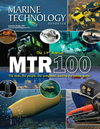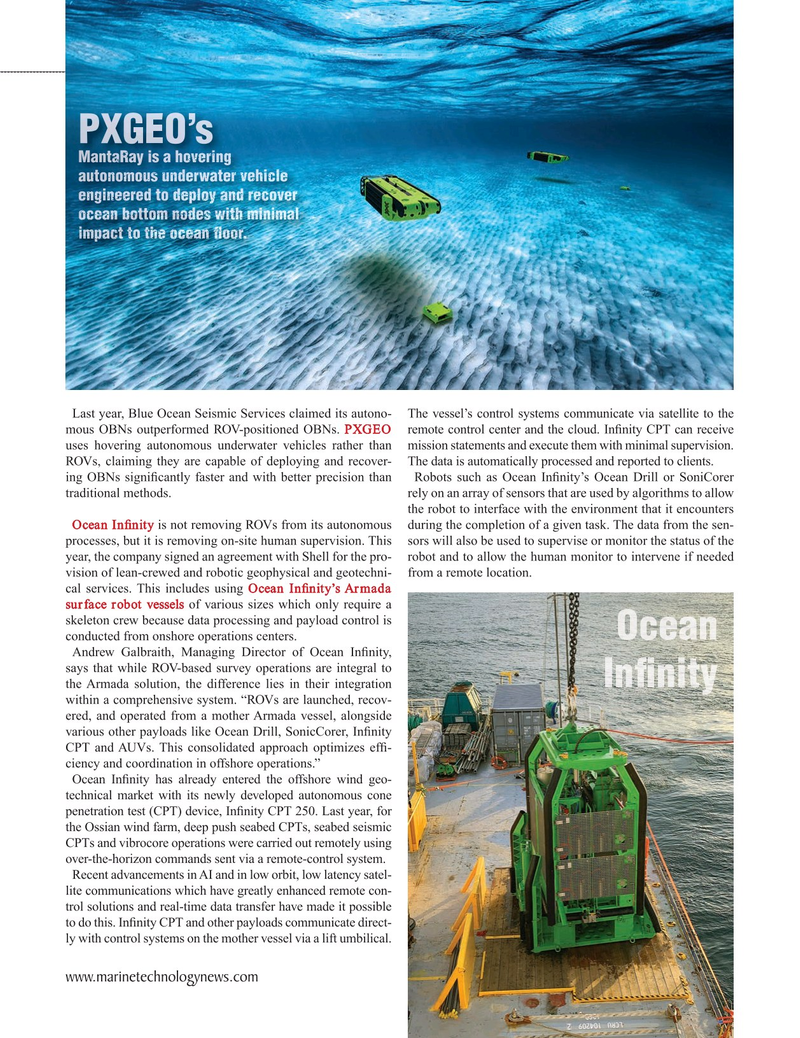
Page 55: of Marine Technology Magazine (September 2024)
Read this page in Pdf, Flash or Html5 edition of September 2024 Marine Technology Magazine
aRay MantaRay i is a a ho hove veri ring ng wate wa mous nd nderwa mo au uto tono nomous u und nde erwate ter r r ve ve vehi hi hicl cl cle e e n r nd ec de depl en en ngi gi gine ne neer er ered ed ed d t t t to o o o o de depl pl ploy oy oy a a and nd r rec ecov ov ov over er er er ma ma ma mi mi mi ma om n o om od om om om bo bo om od oc oc oc ocea ea ea a an n n n n n bo bo o bo bott tt tt t tt t om n n n n nod od od od odes es es es e e w w w w w w wit it it it th h h h h h h mi mi m m ni ni ni n ma a al l l l oo oo oo ea o ocea ea e n oo impa im im im impa p p ct im impa pa a a pact ct ct ct ct ct ct t t t t t to o o o o o th th th th th th t e e e e e e oc oc oc oc o ocea a ea ea ean n n n n n ? ? ? ? ? ? ? oo oo oo or. r. r. r. r r r r. .
Last year, Blue Ocean Seismic Services claimed its autono- The vessel’s control systems communicate via satellite to the mous OBNs outperformed ROV-positioned OBNs. PXGEO remote control center and the cloud. In? nity CPT can receive uses hovering autonomous underwater vehicles rather than mission statements and execute them with minimal supervision.
ROVs, claiming they are capable of deploying and recover- The data is automatically processed and reported to clients.
ing OBNs signi? cantly faster and with better precision than Robots such as Ocean In? nity’s Ocean Drill or SoniCorer traditional methods. rely on an array of sensors that are used by algorithms to allow the robot to interface with the environment that it encounters
Ocean In? nity is not removing ROVs from its autonomous during the completion of a given task. The data from the sen- processes, but it is removing on-site human supervision. This sors will also be used to supervise or monitor the status of the year, the company signed an agreement with Shell for the pro- robot and to allow the human monitor to intervene if needed vision of lean-crewed and robotic geophysical and geotechni- from a remote location. cal services. This includes using Ocean In? nity’s Armada surface robot vessels of various sizes which only require a skeleton crew because data processing and payload control is conducted from onshore operations centers.
Andrew Galbraith, Managing Director of Ocean In? nity, says that while ROV-based survey operations are integral to the Armada solution, the difference lies in their integration within a comprehensive system. “ROVs are launched, recov- ered, and operated from a mother Armada vessel, alongside various other payloads like Ocean Drill, SonicCorer, In? nity
CPT and AUVs. This consolidated approach optimizes ef? - ciency and coordination in offshore operations.”
Ocean In? nity has already entered the offshore wind geo- technical market with its newly developed autonomous cone penetration test (CPT) device, In? nity CPT 250. Last year, for the Ossian wind farm, deep push seabed CPTs, seabed seismic
CPTs and vibrocore operations were carried out remotely using over-the-horizon commands sent via a remote-control system.
Recent advancements in AI and in low orbit, low latency satel- lite communications which have greatly enhanced remote con- trol solutions and real-time data transfer have made it possible to do this. In? nity CPT and other payloads communicate direct- ly with control systems on the mother vessel via a lift umbilical. www.marinetechnologynews.com
MTR #7 (50-65).indd 55 10/3/2024 3:36:32 PM

 54
54

 56
56
